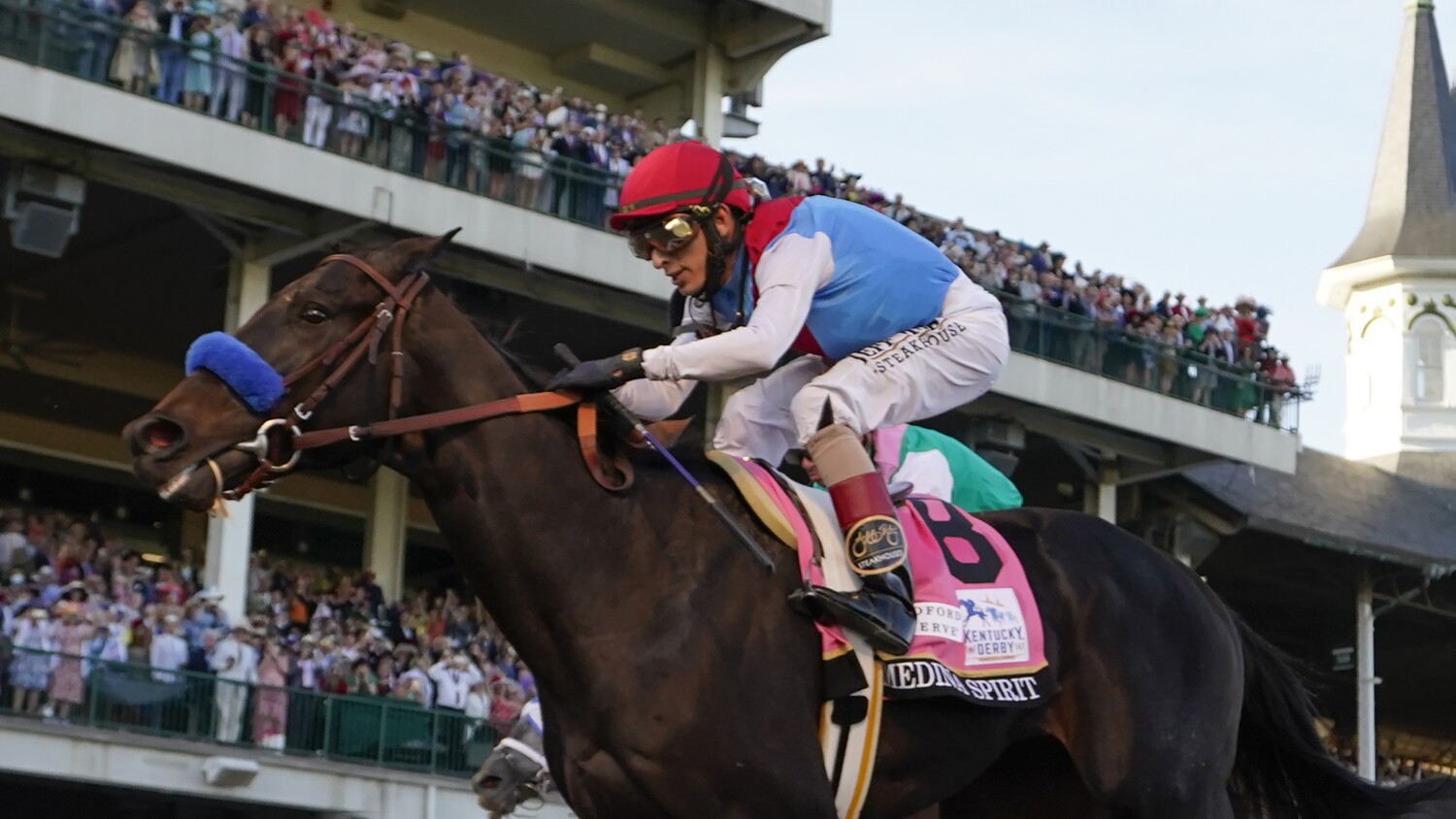
Kentucky Derby winner Medina Spirit moved one step closer to disqualification when the results of a second test came back positive for a banned medication.
Craig Robertson, attorney for trainer Bob Baffert, confirmed that “the Medina Spirit split sample confirmed the finding of betamethasone at 25 picograms.”
The original sample found 21 picograms in the horse’s system. A picogram is a trillionth of a gram. There is no allowable limit for the medication on race day in Kentucky. The split sample testing was done by the Maddy Lab at UC Davis.
The next step will be for the Kentucky Horse Racing Commission to hold a hearing on the case. If it confirms a medication violation, Medina Spirit would be disqualified and $1.8 million in purse money would be forfeited.
Baffert would also face penalties. Guidelines call for a suspension of 10 to 30 days and a fine of $1,500 to $2,500. It would be Baffert’s second Class C violation in Kentucky within a year. The filly Gamine tested positive for betamethasone after running in the Kentucky Oaks in September.
“There is other testing being conducted, including DNA testing,” Robertson said. “We expect this additional testing to confirm that the presence of the betamethasone was from the topical ointment, Otomax, and not an injection.”
The KHRC has yet to confirm the positive test and it was made public by Baffert about a week after the Kentucky Derby. At first, he said he had no idea how the drug got in the horse’s system. He went on media outlets defending his horse and proclaiming innocence. In one interview with Fox News, he blamed “cancel culture.”
However, two days later he said the source of the drug had been identified: an ointment used to treat a skin rash on the hindquarters of Medina Spirit. The treatment started shortly after the Santa Anita Derby and continued until the day before the Kentucky Derby. Betamethasone is usually administered to horses by injection but is also available as a topical ointment.
Clark Brewster, an attorney for Medina Spirit’s owner, Amr Zedan, said the Maddy Lab only tested for the presence of betamethasone and did not do additional tests requested by Zedan and Baffert.
“We asked that the split be analyzed to determine if there were other detectable compounds that it was the topical salve and it wasn’t allowed,” Brewster said. “It makes the split confirmation of rather dubious value.
“We were able to persuade the KHRC to send the original sample to another [Racing Medication and Testing Consortium] accredited lab to determine if they can find empirically if other compounds were present showing it was the salve. … The whole basis of why betamethasone is listed is that they don’t want horses’ joints injected fewer than 14 days before the race. It’s not about the salve.”
Betamethasone is a corticosteroid primarily used as an anti-inflammatory on humans and animals. It is not considered a performance enhancer and its use is legal but needs to be out of the horse’s system by race day. The typical withdrawal window is 14 days or less.
Regulators don’t want horses on the medication when they race so veterinarians can feel for heat on the animals’ limbs in pre-race examinations, according to Dr. Mary Scollay, executive director and chief operating officer at the RMTC.
“You don’t want to increase the chance of injury by not being able to detect a problem,” Scollay told The Times last month. “It helps the trainer, groom, everyone who comes in contact with the horse. You don’t want medication to fool them into poor decision making.”
Upon learning of the positive test, Churchill Downs temporarily banned Baffert from racing at the track. Medina Spirit was allowed to race in the Preakness, but only after passing two pre-race drug tests. It was only after Medina Spirit ran third in the Preakness and appeared unlikely to run in the Belmont Stakes that the New York Racing Assn. also temporarily banned Baffert. Both moves were largely symbolic because Baffert does not typically run horses at those tracks.
The Belmont Stakes, the third leg of racing’s Triple Crown, will be held Saturday.
Baffert, considered the face of racing due to his success in the sport, has been dogged by medication positives the past two years. This is his fifth violation during that time. In two of the cases he was fined, with no penalty to the horse or ownership because the positives were caused by inadvertent contamination that also affected other barns.
The KHRC and the New York State Gaming Commission have not taken any action against Baffert, and neither has the California Horse Racing Board.
“They face the same issue the CHRB does in that regulators cannot suspend or revoke occupational licenses without a hearing and due process,” the CHRB said in a statement. “Should any regulatory body take action against any licensee, we would reciprocate that action in California.”
If Medina Spirit were to be disqualified for a medication violation, it would be only the second such disqualification in the 147-year history of the Kentucky Derby. In 1968, Dancer’s Image was disqualified for having phenylbutazone, an anti-inflammatory, in his system. It took four years to settle the case after extensive litigation.
window.fbAsyncInit = function() { FB.init({
appId : '134435029966155',
xfbml : true, version : 'v2.9' }); };
(function(d, s, id){ var js, fjs = d.getElementsByTagName(s)[0]; if (d.getElementById(id)) {return;} js = d.createElement(s); js.id = id; js.src = "https://connect.facebook.net/en_US/sdk.js"; fjs.parentNode.insertBefore(js, fjs); }(document, 'script', 'facebook-jssdk'));
Stay connected with us on social media platform for instant update click here to join our Twitter, & Facebook
We are now on Telegram. Click here to join our channel (@TechiUpdate) and stay updated with the latest Technology headlines.
For all the latest Sports News Click Here
For the latest news and updates, follow us on Google News.
